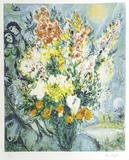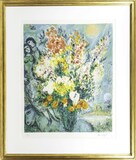Bouquet illuminant le ciel
Marc Chagall (Witebsk 1887 - St.-Paul-de-Vence 1985)

Lot-No. 357
Proceeds : 1.000 €
1994. Farblithographie. 70 x 57,5 cm. Lo. ri. in the print sign. Marc Chagall, lo. le. num. 88/250, matted and frarmed under glass, uninspected out of frame. - One of the most important artists of the 20th century, whose beginnings lay in Fauvism and who later found a distinctive lyrical-modern form of expression. C. attended private painting schools in St. Petersburg after failing to gain admission to the academy. With the help of a scholarship, he was able to move to Paris in 1910, where he soon found a connection to the avant-garde art scene and was able to take part in the customary exhibitions. During a visit to Russia, the First World War broke out and prevented C. from returning to Paris. He was unable to assert himself against Malevich as a cultural functionary of the Revolution and, after a stop in Berlin, he returned to France. Persecution of the Jews forced him into exile in New York in 1941-48, where he was honoured with a retrospective at MoMA. Back in France, he exhibited in many important European museums as well as at Documenta and received important public commissions. Mus.: New York (MoMA, Guggenheim Mus.), Paris (Centre Pompidou), London (Tate), Amsterdam (Stedelijk Mus.), Zurich (Kunsthaus), Chicago (Art Institute) a. others. Lit.: AKL, Mourlot/Sorlier: Chagall - Lithographe a. others.
Marc Chagall: Bouquet illuminant le ciel
Marc Chagall (Witebsk 1887 - St.-Paul-de-Vence 1985)
Bouquet illuminant le ciel
Lot-No. 357
Proceeds : 1.000 €
1994. Farblithographie. 70 x 57,5 cm. Lo. ri. in the print sign. Marc Chagall, lo. le. num. 88/250, matted and frarmed under glass, uninspected out of frame. - One of the most important artists of the 20th century, whose beginnings lay in Fauvism and who later found a distinctive lyrical-modern form of expression. C. attended private painting schools in St. Petersburg after failing to gain admission to the academy. With the help of a scholarship, he was able to move to Paris in 1910, where he soon found a connection to the avant-garde art scene and was able to take part in the customary exhibitions. During a visit to Russia, the First World War broke out and prevented C. from returning to Paris. He was unable to assert himself against Malevich as a cultural functionary of the Revolution and, after a stop in Berlin, he returned to France. Persecution of the Jews forced him into exile in New York in 1941-48, where he was honoured with a retrospective at MoMA. Back in France, he exhibited in many important European museums as well as at Documenta and received important public commissions. Mus.: New York (MoMA, Guggenheim Mus.), Paris (Centre Pompidou), London (Tate), Amsterdam (Stedelijk Mus.), Zurich (Kunsthaus), Chicago (Art Institute) a. others. Lit.: AKL, Mourlot/Sorlier: Chagall - Lithographe a. others.




